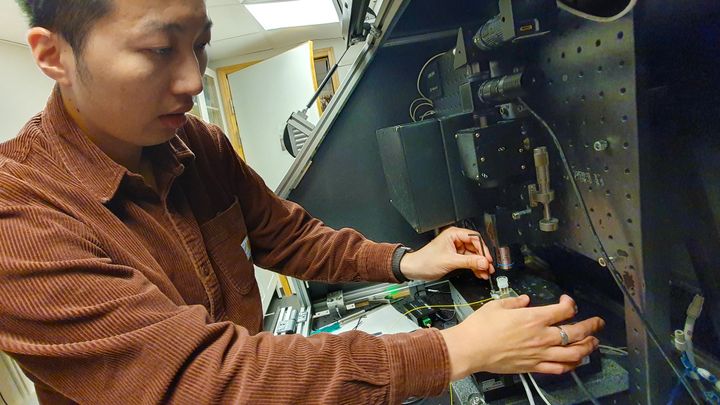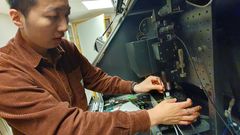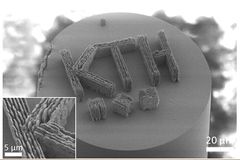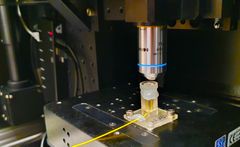1,000 times smaller than a grain of sand—glass sensors 3D-printed on optical fiber
In a first for communications, researchers in Sweden 3D printed silica glass micro-optics on the tips of optic fibers—surfaces as small as the cross section of a human hair. The advance could enable faster internet and improved connectivity, as well as innovations like smaller sensors and imaging systems.

Reporting in the journal ACS Nano, researchers at KTH Royal Institute of Technology in Stockholm say integrating silica glass optical devices with optical fibers enables multiple innovations, including more sensitive remote sensors for environment and healthcare.
The printing techniques they report also could prove valuable in production of pharmaceuticals and chemicals.
KTH Professor Kristinn Gylfason says the method overcomes longstanding limitations in structuring optical fiber tips with silica glass, which he says often require high-temperature treatments that compromise the integrity of temperature-sensitive fiber coatings. In contrast to other methods, the process begins with a base material that doesn't contain carbon. That means high temperatures are not needed to drive out carbon in order to make the glass structure transparent.
The study's lead author, Lee-Lun Lai, says the researchers printed a silica glass sensor that proved more resilient than a standard plastic-based sensor after multiple measurements.
"We demonstrated a glass refractive index sensor integrated onto the fiber tip that allowed us to measure the concentration of organic solvents. This measurement is challenging for polymer-based sensors due to the corrosiveness of the solvents," Lai says.
"These structures are so small you could fit 1,000 of them on the surface of a grain of sand, which is about the size of sensors being used today," says the study's co-author, Po-Han Huang.
The researchers also demonstrated a technique for printing nanogratings, ultra-small patterns etched onto surfaces at the nanometer scale. These are used to manipulate light in precise ways and have potential applications in quantum communication.
Gylfason says the ability to 3D print arbitrary glass structures directly on fiber tip opens new frontiers in photonics. "By bridging the gap between 3D printing and photonics, the implications of this research are far-reaching, with potential applications in microfluidic devices, MEMS accelerometers and fiber-integrated quantum emitters," he says.
Images



Subscribe to releases from KTH Royal Institute of Technology
Subscribe to all the latest releases from KTH Royal Institute of Technology by registering your e-mail address below. You can unsubscribe at any time.
Latest releases from KTH Royal Institute of Technology
To compete globally, Europe’s seafood farmers may get boost from AI research14.11.2024 13:30:27 CET | News
Underwater drones adapted to cold Nordic waters, and sensors that listen to the sounds of fish eating. These are some of the AI solutions that could give European sea farmers a boost to compete globally. Researcher Fredrik Gröndahl explains how maching learning is being developed take on operational challenges and reduce costs in aquaculture, particularly in inaccessible waters far offshore.
3D printing method may improve micro energy storage14.10.2024 14:55:18 CEST | Press Release
One key to making portable devices more compact and energy efficient lies in the precise nanoscale form of energy-storing capacitors. Researchers in Sweden report they've cracked the challenge with a unique 3D printing method.
Method to remove microplastics from water could also speed up blood analyses15.8.2024 11:36:46 CEST | Press Release
Researchers demonstrated a way to speed up—and potentially scale up—the process for separating particles in fluids, which can be used for studying microplastics in drinking water or even analyzing cancer cells from blood.
Leading academics call for extending, reframing Sustainable Development Goals17.6.2024 10:46:06 CEST | Press Release
A group of leading academics are calling for the UN Sustainable Development Goals to be extended past their 2030 target date and updated with consideration for the impact of artificial intelligence (AI), and with more input from communities affected by the goals, among other recommendations.
Climate is one culprit in spread and growth of Middle East dust levels30.4.2024 08:49:52 CEST | Press Release
Climate change is transforming dust storms—a natural phenomenon in the Middle East—into a more frequent and widespread threat to health and economies throughout the region, a new study shows.
In our pressroom you can read all our latest releases, find our press contacts, images, documents and other relevant information about us.
Visit our pressroom